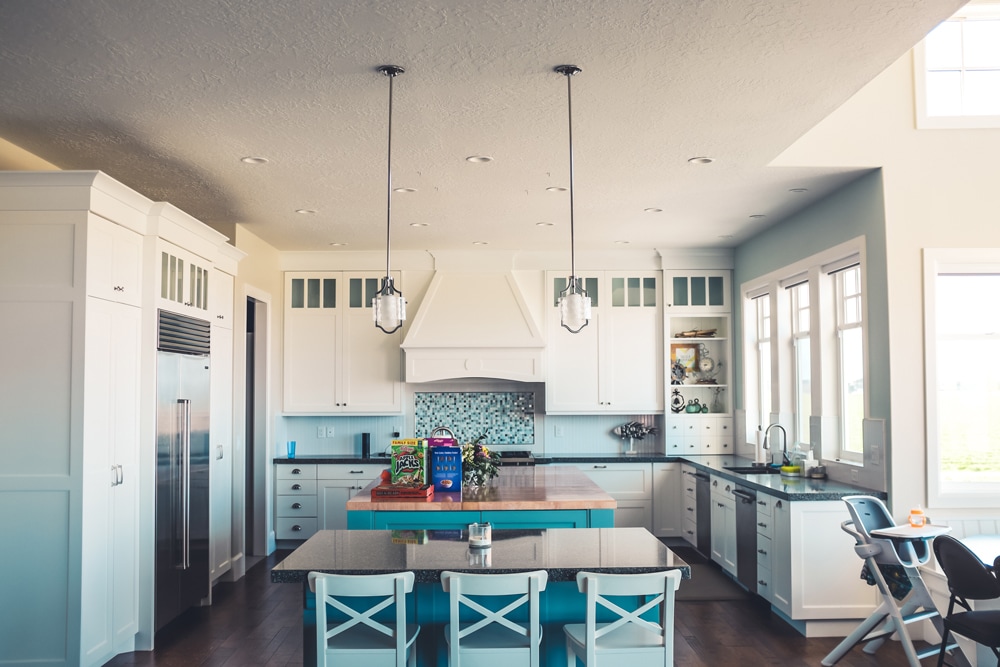Kitchen renovation comprises various components that must be planned and considered carefully for the job to be successful.
The first and most important thing to consider when diving into the world of kitchen renovation is your budget. Without a comprehensive and well-thought-out budget, your project will have no direction and no guideline for what you can afford and what you should put your money into.
 Although most people tend to blame contractors for costs that go over budget, the homeowner must ensure the kitchen renovation cost stays within the budget. You have to remember that most of the secondary parties involved in the job will be concerned about their profitability and not your finances. Even if you hire one that will try to find ways to help you save money, you must still remind them to keep the budget manageable as the work continues.
Although most people tend to blame contractors for costs that go over budget, the homeowner must ensure the kitchen renovation cost stays within the budget. You have to remember that most of the secondary parties involved in the job will be concerned about their profitability and not your finances. Even if you hire one that will try to find ways to help you save money, you must still remind them to keep the budget manageable as the work continues.
These 15 tips will help you stay on budget when you start remodeling your kitchen.
1. HAVE A GRAND PLAN FOR YOUR KITCHEN RENOVATION
The kind of renovation you want to do should determine the level of planning. Minimal projects like repainting cabinets or changing countertops may go well with little to no planning. Still, major renovations like extending the kitchen or changing its layout must be worked out properly. Work with designers to draft a practical plan that will end up saving you time and money later. You will spend some money upfront but avoid expensive errors associated with poor planning.
Think about how long you intend to keep the house and use that as a guideline for the planning. If you intend to sell shortly after, the renovation should be more of an investment to increase home value.
2. BE PREPARED BEFORE YOU START KITCHEN REMODELING
Part of preparation is figuring out what you want to change or add to the kitchen. Visualize the space and decide on the placement of all elements and fixtures before the demolition begins. Keep in mind, buying items as the renovation continues can lead to the budget quickly spiralling out of control. It is, therefore, better to purchase all the required items before commencing the project.
The main problem with late purchases is the possibility associated with backorders. If one of the items you need is out of stock, you will be forced to buy a different one, which may come at a higher cost, or wait until the specific item arrives, which may take too long. Either way, the renovation will be affected. Your contractor may even charge you extra for the additional work they have to do or the extended renovation period.
3. DON’T MISS ANY DETAILS FOR YOUR BUDGET KITCHEN RENOVATION
The only way to budget is to be thorough. People who miss or get lazy on planning the details find themselves in deep water quickly. Something as simple as mis-judging how much your wood nails will cost can send your budget into space and you’ll be wondering what happened. Rule number 1 for staying on budget is to look deeply into every detail of the project so you don’t underestimate your budget.
4. CONSIDER ADDITIONAL KITCHEN REMODELING EXPENSES
Don’t forget to look outside the actual renovation for costs you’ll be responsible for like hotels if you plan on leaving your home at any point during the reno or getting food out more often than usual because your kitchen isn’t fit for cooking at home. These expenses can sneak attack your budget if you don’t account for them beforehand.
5. MAKE A LIST OF YOUR KITCHEN RENOVATION PRIORITIES
Prioritize the various components of the renovation, whether it is new custom or traditional cabinetry, appliances, or flooring. By listing the most important elements down, you will predict the costs more accurately and be better prepared if you encounter price changes.
Think about the functionality of the priorities as well as their visual appeal. Imagine how they would look with decorative touches such as crown moulding and elegant faucets. Consider the performance of those elements and determine if you can do without them. You may also find cheaper alternatives without compromising the usability of the kitchen. Always refer to your list as you source the materials.
6. REFURBISH KITCHEN APPLIANCES
Unlike before, when appliances were disposed of in landfills during kitchen renovations, now they can be revamped and reused. Most municipalities have imposed restrictions about sending old appliances directly to the landfills, with information about their proper use being easily accessible.
The availability of many online platforms accepting the old appliance components has also made it easier for homeowners to get rid of them correctly. Instead of paying more money for brand new devices, refurbish the old ones at a lower cost. Some of the gadgets you can try reusing include microwaves, refrigerators, dishwashers, water heater and softener, and garbage disposal.
Before doing repairs, determine the extent of damage on the appliances and whether they can still function as they did before. If you have the right skills, you can refurbish them as DIY to save more money. Otherwise, hire a professional. You will still spend less than you would on a new gadget.
7. USE UP ALL MATERIALS YOU BOUGHT FOR YOUR KITCHEN RENOVATION
Kitchen remodelling can end up with a lot of waste materials that can be expensive to dispose of, as shown by statistics that indicate the average as 10%. Rather than let the small remaining pieces go to waste, find a way to reuse them. For example, you can turn remnant granite materials into beautiful cutting boards or create rollout inserts from wood leftover from cabinet installation. Creative contractors can help you out with this, but you have to ask them.
8. REFRESH RATHER THAN REPLACE KITCHEN CABINETS
Kitchen renovations that involve tearing down the place and installing new features are more expensive than those that reuse most items. A good example is cabinetry. Buying new cabinets, especially custom ones, is very costly. A more cost-efficient option is refreshing them. It also allows you to save the environment by ensuring you do not add more waste to the surrounding.
Refacing: Refacing is slightly more expensive than other refreshing options like painting, but it gives some of the best results. It is done on cabinets that have scratches or are too worn out. It involves replacing the doors and veneers on the outside surfaces. If you do not have the right tools to achieve this, hire experts. It will be less costly compared to buying new cabinets.
Painting: Painting is one of the easiest and cheapest refreshing methods. However, the process is time-consuming because of the necessary preparation. The cabinets will have to be sanded down before priming and painting is done. You can achieve excellent results even if you do it as a DIY.
Shelving: Another alternative is to do away with the cabinets and install open shelves instead. They are cheaper than cabinets, but they still provide the same functionality. It is also easier to match them to the kitchen décor. They also have a way of making the room airy, especially if it is smaller.
Hardware: Updating the accessories and hardware used on the cabinets can also give them the transformation you need. New doorknobs and handles will be less expensive, but they will give the fixtures a brand-new look.
If you decide to replace the fixtures, choose pieces that are easy to work with to save on labour costs. The only challenge with ready-to-assemble cabinets is finding the right fit for the kitchen, especially around corners or irregular angles.
9. GO LOW ON YOUR KITCHEN FLOORS
Work on hardwood floors even if the main renovation does not involve changing them. If you are demolishing walls in the kitchen, place floorboards in those sections where the wall was and sand them. Stain both the new floors and old ones to make them uniform and give them a fresh appearance.
If your floors are tile or vinyl, change them into a less expensive type such as sealed cork. They can be installed on various types of subfloors and are more comfortable under the feet. However, you have to be careful with water exposure because they are permeable. A sealant can solve that problem for you.
10. DECIDE WHETHER YOU ARE GOING TO STAY AT HOME WHILE KITCHEN RENOVATIONS ARE TAKING PLACE
Living in the same house with construction going on can be very stressful. If possible, arrange to live in a different location, but include the accommodation costs in the renovation budget. Consider storage fees and transportation costs for your possessions.
Staying in the house may be cheaper, but you will end up being frustrated with the noise and dust. If you can handle it for the duration of the renovation, create a separate cooking area, which may also come at a cost.
11. ADD ARCHITECTURAL INTEREST TO YOUR KITCHEN
Adding details on the premises can make a huge difference that makes your kitchen stand out from the rest. If you have free-standing cabinetry, you can add bun feet to give it a more realistic feel. You can also add beadboard panelling to a kitchen island if you have one.
Another idea is to add mosaic tiles, but you can also get creative and install a focal point using low-cost methods. For example, having stacked stone at the back of the island can give the kitchen a unique aspect and ensure it retains its full functionality. Your design team can help you with more ideas.
12. KEEP PLUMBING WHERE IT IS
Changing plumbing fixtures is one of the most tedious and expensive renovation ideas you can start. It requires adding or replacing pipes and changing the layout of the kitchen to match the new plumbing installation. To avoid all this, leave the plumbing where it is, which means not interfering with appliances like the dishwasher or sink. The average cost of changing them is $5,000. You can still have them inspected and repaired where necessary.
13. MAKE SURE YOU HAVE OPTIONS
For cases where you find your budget getting squeezed, having a backup plan for what material your countertops will be or what kind of wood your kitchen cabinets will be can save you. Downgrading your countertops to something slightly less expensive can be a good sacrifice if it allows you to get that stainless-steel fridge or that extra stylish island.
14. DO SOME OF THE KITCHEN RENOVATION WORK YOURSELF
If you’ve ever seen a home reno show, you’ve seen the designer/builder suggest to the homeowner that he or she pick up a paintbrush or a sledgehammer and help out to save money and time. Determine what you can do and what you have time for, and put yourself to work on your reno to make sure you stay on track with your budget.
15. KEEP EVERY RECEIPT
There is nothing more disastrous than losing track of what you’re spending. It’s the most effective way to destroy your budget, leave you confused and stressed, and find yourself at the end of your reno thousands of dollars beyond what you initially thought you’d spend. If you go as far as creating a detailed budget, don’t get lazy about tracking it. Failing to track your costs makes the budget useless.
It’s simply too easy to go over budget on your home renovation projects. Without careful consideration of the details, you can easily find yourself stressed out and unable to finish your renovation to the quality and standard you first envisioned. For help with your DIY project, call us and let us guide and help you through your spring kitchen remodelling project. Visit us to learn more about Kitchen Renovation.





